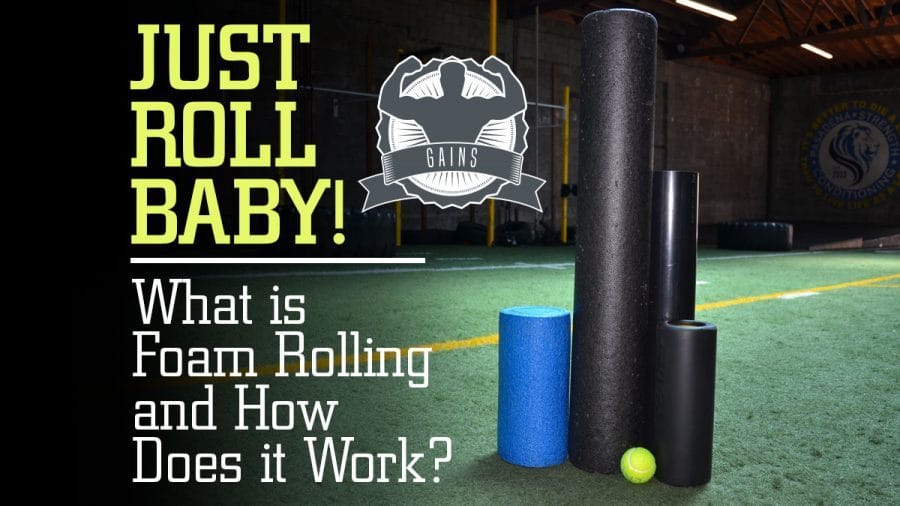Just Roll Baby! What is Foam Rolling and How Does it Work?

There are many names for soft tissue work. SMR or Self-Myofascial Release was the term I was taught when I obtained my first personal training certification. It mainly encompassed using a foam roller or lacrosse ball on a specific muscle group. Foam rolling can be used to obtain new pain-free range of motion by applying pressure to the tissues. There may also be benefits for muscle recovery and/or decreasing Delayed-Onset Muscle Soreness (DOMS), a fancy term for soreness. Nowadays, there are thousands of tools used for soft tissue work and the term SMR itself may be antiquated in light of new research. Since the foam roller is the term most will be familiar with, we will use foam rolling as a term to encompass all forms of soft tissue work.
There is plenty of debate and confusion over the efficacy of foam rolling. The idea that foam rolling can improve "tissue quality" or “break up adhesions" in the fascia is seen as implausible by most experts. Fascia holds our body together and is very strong. The pressure of a foam roller likely cannot change the structural properties of fascia. Furthermore, there is no evidence that concludes foam rolling can cause noticeable structural changes in the fascia. One research study has shown that the forces required to deform fascia would not be possible using any traditional (non-medieval) forms of manual therapy let alone a foam roller. (1) Most evidence-based experts agree that foam rolling likely works due to neurological mechanisms.
If there is no strong evidence for foam rolling then why do we do it?
Despite lack of significant evidence for how it works, foam rolling works! It is hypothesized that the central nervous system (CNS), which is comprised of the brain and spinal cord, is behind the changes and benefits of foam rolling. The benefits of foam rolling are often temporary and must be repeated regularly, which suggest that the mechanism is associated with the CNS and not an actual change in the tissue. This also answers the questions of why people who start with a basic soft foam roller eventually graduate to much harder tools. How often have you seen someone say they can’t feel a regular foam roller anymore and must use a PVC pipe, then a lacrosse ball, and then eventually they move on to using a spiked paddle, then an electronic massage device such as the TheraGun or HyperVolt. The CNS (brain and spinal cord) become familiar to the stimulus much like how you can develop a tolerance to a drug such as caffeine. In order to receive the same effect, you must switch to a harder tool much like switching to a stronger drug or taking a larger dose.
Why should I foam roll if the effects are only temporary?
Foam rolling will temporarily increase the range of motion (ROM) and can provide pain relief. This provides a window of opportunity to create permanent change through exercise done immediately after. This window allows you to train movements that would not normally be accessible by increasing ROM and/or reducing pain associated with a certain movement. It is also important to note that using a foam roller for soft tissue work does not decrease strength, such as prolonged static stretching when compared to other modalities that increase ROM. (2) So there are no real obvious drawbacks to foam rolling other than time spent.
So then how does it work?
To sum it up, there is very little evidence on foam rolling for increasing performance, and we don’t really know the exact mechanism behind how it works. And that’s ok. If you are getting results, then keep using it as we wait for more research to be conducted. My recommendation is to use foam rolling as a way to increase the range of motion before exercise to reinforce that range of motion during exercise. This method hopefully will give you long-lasting results and allow you to use the newly gained range of motion over time. However, if you don’t enjoy foam rolling and find it to be a waste of your time, then you can skip it in favor of a more functional warm-up suited to your needs. There is no evidence that you need to foam roll in order to stay healthy or stay in optimal shape.
KEY TAKEAWAYS:
- Current evidence points to the trend that there is no effect on the actual tissue itself.
- Foam rolling increases ROM acutely through neurophysiological mechanisms.
- There may be benefits for muscle recovery and decreased soreness.
Foam Rolling the Hip-FlexorEmbedded iFrame
Foam Rolling the Lats
Embedded iFrame
Foam Rolling the Triceps
Embedded iFrameREFERENCES
- Chaudhry H, Schleip R, Ji Z, Bukiet B, Maney M, Findley T. Three-Dimensional Mathematical Model for Deformation of Human Fasciae in Manual Therapy. J Am Osteopath Assoc 2008;108(8):379–390.
- PEACOCK CA, KREIN DD, SILVER TA, SANDERS GJ, VON CARLOWITZ K-PA. An Acute Bout of Self-Myofascial Release in the Form of Foam Rolling Improves Performance Testing. International Journal of Exercise Science. 2014;7(3):202-211.
